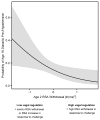Vagal Regulation of Cardiac Function in Early Childhood and Cardiovascular Risk in Adolescence
- PMID: 28207613
- PMCID: PMC5489373
- DOI: 10.1097/PSY.0000000000000458
Vagal Regulation of Cardiac Function in Early Childhood and Cardiovascular Risk in Adolescence
Abstract
Objective: Poor behavioral self-regulation in the first 2 decades of life has been identified as an important precursor of disease risk in adulthood. However, physiological regulation has not been well studied as a disease risk factor before adulthood. We tested whether physiological regulation at the age of 2 years, in the form of vagal regulation of cardiac function (indexed by respiratory sinus arrhythmia [RSA] change), would predict three indicators of cardiovascular risk at the age of 16 years (diastolic and systolic blood pressure and body mass index).
Methods: Data came from 229 children who participated in a community-based longitudinal study. At the age of 2 years, children were assessed for RSA baseline and RSA change (ln(ms)) in response to a series of challenge tasks. These same children were assessed again at the age of 16 years for diastolic and systolic blood pressure (millimeters of mercury), height (meters), and weight (kilogram).
Results: Regression analyses revealed that less RSA withdrawal at the age of 2 years predicted higher diastolic blood pressure at the age of 16 years, adjusting for demographic characteristics (B = -3.07, M [S E] = 1.12, p = .006). Follow-up analyses demonstrated that these predictions extended to clinically significant levels of diastolic prehypertension (odds ratio = 0.43, 95% confidence interval = 0.22-0.89). RSA withdrawal did not significantly predict adolescent body mass index or systolic blood pressure.
Conclusions: Vagal regulation of cardiac function in early childhood predicts select indicators of cardiovascular risk 14 years later. Early signs of attenuated vagal regulation could indicate an increased risk for elevated blood pressure before adulthood. Future research should test biological, behavioral, and psychological mechanisms underlying these long-term predictions.
Conflict of interest statement
Figures
Similar articles
-
Cardiac vagal control mediates the relation between past depression and blood pressure several years later among young adults.Psychophysiology. 2020 May;57(5):e13535. doi: 10.1111/psyp.13535. Epub 2020 Jan 27. Psychophysiology. 2020. PMID: 31985075 Free PMC article.
-
Respiratory Sinus Arrhythmia as an Index of Cardiac Vagal Control in Mitral Valve Prolapse.Physiol Res. 2020 Mar 27;69(Suppl 1):S163-S169. doi: 10.33549/physiolres.934402. Physiol Res. 2020. PMID: 32228022 Free PMC article.
-
Cardiac vagal regulation differentiates among children at risk for behavior problems.Biol Psychol. 2007 Feb;74(2):144-53. doi: 10.1016/j.biopsycho.2006.09.005. Epub 2006 Oct 18. Biol Psychol. 2007. PMID: 17055141 Free PMC article.
-
Toward understanding respiratory sinus arrhythmia: relations to cardiac vagal tone, evolution and biobehavioral functions.Biol Psychol. 2007 Feb;74(2):263-85. doi: 10.1016/j.biopsycho.2005.11.014. Epub 2006 Nov 1. Biol Psychol. 2007. PMID: 17081672 Review.
-
Respiratory sinus arrhythmia as a potential measure in substance use treatment--outcome studies.Addiction. 2016 Apr;111(4):615-25. doi: 10.1111/add.13232. Epub 2016 Jan 5. Addiction. 2016. PMID: 26567088 Free PMC article. Review.
Cited by
-
Prenatal Exposure to and Cardiac Vagal Tone during Infancy: Findings from a Multiethnic Birth Cohort.Environ Health Perspect. 2019 Oct;127(10):107007. doi: 10.1289/EHP4434. Epub 2019 Oct 30. Environ Health Perspect. 2019. PMID: 31663780 Free PMC article.
-
Temperamental vulnerability to emotion dysregulation and risk for mental and physical health challenges.Dev Psychopathol. 2019 Aug;31(3):957-970. doi: 10.1017/S0954579419000415. Epub 2019 May 17. Dev Psychopathol. 2019. PMID: 31097043 Free PMC article.
-
Discrimination, sleep, and physical health: Moderation by respiratory sinus arrythmia reactivity.J Health Psychol. 2025 Jan 7:13591053241310165. doi: 10.1177/13591053241310165. Online ahead of print. J Health Psychol. 2025. PMID: 39764748 Free PMC article.
-
Relationships Between Adiposity Measures and Heart Rate Variability in Children and Adolescents.Pediatr Cardiol. 2025 Jul 10. doi: 10.1007/s00246-025-03924-3. Online ahead of print. Pediatr Cardiol. 2025. PMID: 40637856
-
Polymorphic variation in the SLC5A7 gene influences infant autonomic reactivity and self-regulation: A neurobiological model for ANS stress responsivity and infant temperament.Psychoneuroendocrinology. 2018 Nov;97:28-36. doi: 10.1016/j.psyneuen.2018.06.019. Epub 2018 Jun 25. Psychoneuroendocrinology. 2018. PMID: 30005279 Free PMC article.
References
-
- Din-Dzietham R, Liu Y, Bielo MV, Shamsa F. High blood pressure trends in children and adolescents in national surveys, 1963 to 2002. Circulation. 2007;116:1488–96. - PubMed
-
- Muntner P, He J, Cutler JA, Wildman RP, Whelton PK. Trends in blood pressure among children and adolescents. Jama. 2004;291:2107–13. - PubMed
-
- Ford ES, Capewell S. Coronary heart disease mortality among young adults in the U.S. from 1980 through 2002: Concealed leveling of mortality rates. J Am Coll Cardiol. 2007;50:2128–32. - PubMed
MeSH terms
Grants and funding
LinkOut - more resources
Full Text Sources
Other Literature Sources


